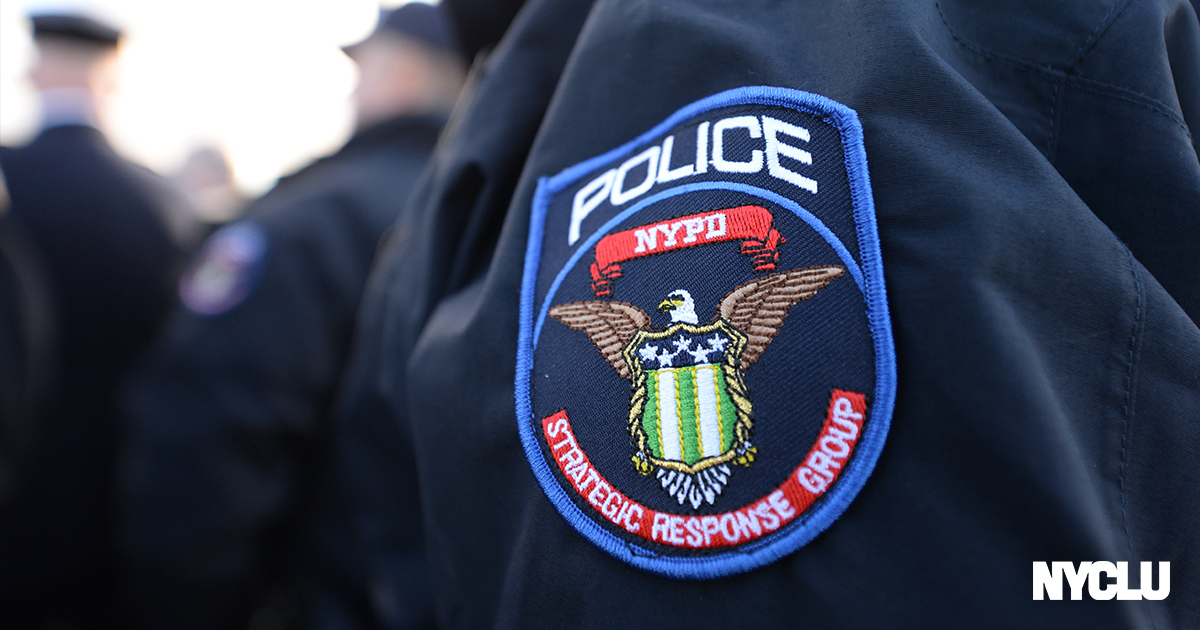Why We Must Disband this Protest-Busting NYPD Unit
To protect the safety and First Amendment rights of New Yorkers, the Strategic Response Group must be disbanded

On January 18, protestors marched across the Brooklyn Bridge in honor of Martin Luther King Jr Day, stopping only to break into song and dance. But when they reached City Hall Park in Manhattan, they were met by police officers clad in riot gear.
Officers flooded the streets and ordered everyone to clear the roadway. Protesters obliged, but moments later, officers in the NYPD’s Strategic Response Group (SRG) charged at the marchers. They pushed, pummeled, and dragged protesters into the street. By the end of the night, 28 people were arrested.
For more than a year, the NYCLU’s protest monitors have witnessed and documented incidents like this across New York City. A clear pattern quickly emerged: When SRG arrives on the scene, officers escalate situations and injure New Yorkers who are exercising their First Amendment rights.
To protect the safety and First Amendment rights of New Yorkers, the unit must be disbanded.
An ominous beginning and the brutality that followed
Formed in 2015, the SRG is a rapid-response unit with a budget that ballooned within a year of its founding from $13 million to $90 million.
Despite the Department’s initial claims that the SRG would engage in counterterror work, the NYPD’s public description of the unit does not include counterterrorism. In fact, nearly every policing activity the SRG performs is already carried out by other NYPD agencies. The only unique role the SRG seems to fill is its heavy specialization in the suppression of protest.
During the 2020 racial justice protests, 1,300 officers were added to the SRG’s command and the unit’s brutalization of protestors came into full view. The NYPD is facing numerous lawsuits related to the department’s treatment of protesters during last year’s protests. In many of these lawsuits, the SRG is front-and-center.
On June 4, 2020, the SRG descended on demonstrators in Mott Haven before the 8pm curfew. With demonstrators unable to escape, SRG officers brutally beat, zip-tied, and arrested 263 protesters, medics, and legal observers. Sixty-one people were injured.
The incident prompted a Human Rights Watch report that details the violent police attack, describing SRG and NYPD officers beating trapped protesters with batons, fists, and feet; deploying pepper spray at point-blank range; and using their bicycles as weapons. The report declared the NYPD’s conduct “intentional, planned, and unjustified.”
Between May 2020 and July 2021, NYCLU protest monitors witnessed 40 instances of police arresting non-violent protesters. Monitors documented 24 incidents of “kettling,” a violent and controversial tactic used to trap and arrest protestors, and 39 instances of use of force, including use of bicycles as weapons, batons, and pepper spray. The SRG was present and participating at all but one of these incidents.
Trained to crush protest
The SRG is known for its propensity to turn non-violent protests into brutal police crackdowns. The voluntary unit attracts officers seeking “more action,” who often have long records of misconduct. But the SRG’s pattern of violence is not just the behavior of a few bad actors. Members of the unit are trained to crush protest – especially protest for racial justice – with force.
The SRG’s Field Force Operations manual includes guidelines for mass arrests, sound cannon deployment, and tactical formations like “encirclement.” Described as a formation utilized to “take a group of people into custody,” encirclement is functionally identical to kettling.
In the Bike Squad’s manual, the SRG’s bias is laid bare. Protest groups are divided into two categories: “peaceful” and “violent.” Examples of “violent” protestors are “BLM movement, Occupy Wall Street, and Anti-Trump Demonstrators.”
The SRG’s double standard
These biased SRG trainings help explain the unit’s disparate policing of protests. For example, in 2018, the SRG allowed the Proud Boys to march without a police escort and backed away when members of the white supremacist group attacked counter-protesters. They then escorted Proud Boy founder Gavin McIness to his car.
Our protest monitors have consistently observed that right-wing, white supremacist and pro-police groups almost always protest without any SRG interference. In contrast, Black Lives Matter protests are consistently policed, brutalized, and arrested by the unit.
Bias and misconduct
The SRG has a history of racial bias and misconduct. The NYCLU’s database of New York City’s Civilian Complaint Review Board filings shows that SRG officers receive an abnormally high number of misconduct complaints compared to non-SRG officers. Of officers who were named in at least one complaint while in the SRG, the median number of complaints since 2000 is six. The median number of complaints received since 2000 for all officers in the database is three.
The SRG also has a pattern of targeting people of color. The NYCLU’s database shows there have been 455 complaints filed against SRG officers between 2015 and 2021. Of those complaints that included a victim’s race, the impacted individual was a person of color 91 percent of the time. Sixty-six percent of victims were Black, 21 percent were Latinx, and nine percent were white.
What we need
In the fight to divest, disempower, and demilitarize the police, we have to start by removing the units that do the most harm. We should begin by putting an end to the SRG itself.
The NYPD – with SRG officers enforcing its will – effectively decides who has the right to protest in New York City. That decision should not rest with the NYPD or any police department.
The SRG should be disbanded and its tactics must not be recreated under another name. The unit’s $90 million budget meanwhile, should be reinvested in ways that help, rather than harm New Yorkers.
Disbanding the SRG is a critical step in protecting the First Amendment and removing the specter of violence from protest.
